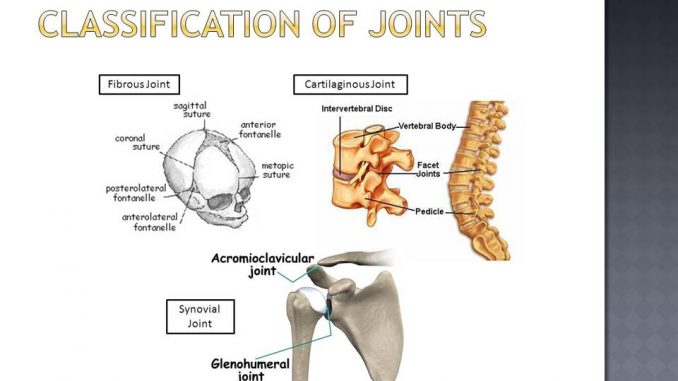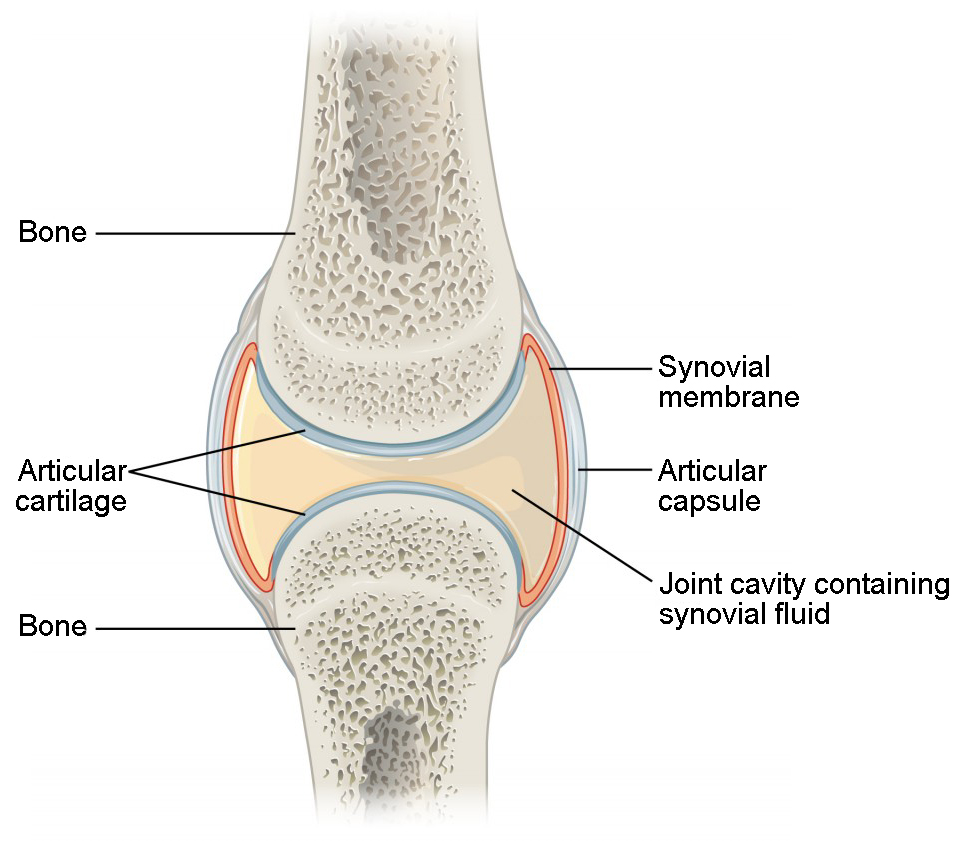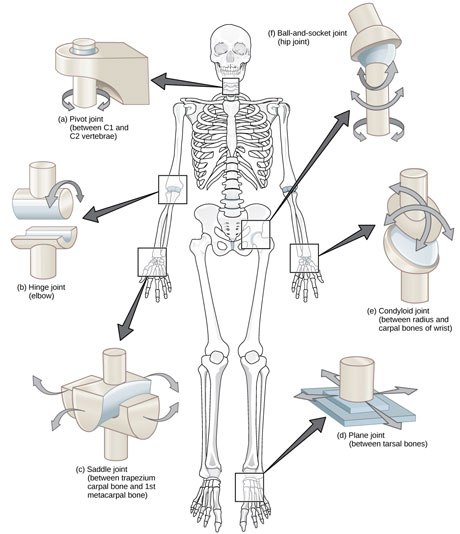
Classification of Joints
- Joint is an articulation or place where two adjacent bone or cartilage meet or joined with each other.
Classification of joints
- On the basis of structure
- On the basis of extent of their function (degree of movement)
Classification of joints on the basis of structure:
- This classification is based on the presence or absence of joint cavity and kinds of supporting tissue that binds two bones together.
I. Fibrous joint
II. Cartilaginous joint
III. Synovial joint
I. Fibrous joint:
- Fibrous joint lacks joint cavity.
- Two bones are joined together by fibrous connective tissue.
- Fibrous joints are joined together tightly so they are generally immobile in adults although some allows slight movement.
Types of fibrous joints
- Suture:
- Syndesmosis
- Gomphosis
1. Suture:
- A suture is a tight union between two or more bones in a skull of adult.
- They are rarely movable.
- Example; sagital sature, squamousal suture, lambdoidal suture and coronal suture
2. Syndesmosis:
- In this joints, bones are close together but not touching each other
- Bones are held together by collagen fibers
- Examples; inferior Tibio-fibula joint, Radius-ulna joint
3. Gomphosis:
- It is fibrous joint made up of peg and socket.
- Example; the root of each teeth is anchored into its socket by fibrous ligament.
II. Cartilaginous joints:
- In cartilaginous joints, bones are united together by a plate of hyaline cartilage.
- Cartilaginous joints lack joint cavity
- They are slightly movable or immobile
Types of cartilaginous joints:
- Synchondrosis
- Symphysis
1. Synchondrosis:
- It is primary cartilaginous joint.
- Synchondrosis is a temporary joint, composed of epiphyseal plate made up of hyaline cartilage that joints epiphysis and diphysis.
- The chief function of synchondrosis is to permit growth of bone but not movement.
- A synchondrosis is eventually replaced by bone when large bone stops growth. However few synchondrosis are still present in adults.
- Example; sternoclavicular joint
2. Symphysis:
- It is called as secondary synchondosis.
- In this joint, two bones are covered by thin layer of hyaline cartilage.
- There is presence of a disk of fibro-cartilage between two bones that acts as shock absorber.
- Example; pubis symphysis
III. Synovial joints:
- Most of the permanent joints of body is synovial joint
- All of the synovial joints allow greatest range of movement.
- Movement is possible because, the end of bone at articulation is covered with smooth hyaline cartilage and joint is lubricated by thick fluid called synovial fluid.
- The joint is covered by flexible articular capsule

Types of synovial joints;
- Hinge joint
- Pivot joint
- Condyloid joint
- Gliding joint
- Saddle joint
- Ball and Socket joint

1. Hinge joint:
- Hinge joint roughly resembles the hinge on the lid of a box.
- The movement of hinge joint is uniaxial.
- The convex surface of one bone fits on concave surface of other bone to permit uniaxial movement.
- Example; Knee joint, Elbow joint, Ankle joint
2. Pivot joint:
- Pivot joint is composed of a central bony pivot surrounded by a collar made partly of bone and partly of ligament.
- The movement of pivot joint is uniaxial and is able to rotate around a central axis.
- Example; Atlantoaxial joint between atlas and axis.
3. Condyloid joint:
- Condyloid joints are modification of ball and socket joint.
- The movement of condyloid joint is biaxial, because of ligament and muscles.
- Example; Metacarpophalangeal joint of fingers (except Thumb)
4. Gliding joint:
- Gliding joints are always small and formed by flat articular surface so that one bone slides on another bone.
- The movement of gliding joint is multiaxial
- Examples; Articular process of Vertebrae, Clavicular joint
5. Saddle joint:
- The saddle joint is so named because both the bones at articulation are shaped like saddle
- Bones have both concave and convex area at right angle to each other.
- Examples; Carpometacarpal joint of thumb.
6. Ball and Socket joint:
- Ball and socket joint is composed of globe like head of one bone that fits into a cup like cavity on another bone.
- It is the most freely movable joint of all joints.
- The movement of ball and socket joint is multiaxial.
- Examples; shoulder and hip joints.
Classification of joints on the basis of degree of movement
- Immobile joint ( Synarthrosis): examples; suture of skull, syndesmosis, gomphosis, synchondrosis
- Slightly movable joint ( Amphi-arthrosis): examples; symphysis
- Freely movable joint ( Diarthrosis): examples; Synovial joints
